In the following post, I note the distinguishing characteristics of Ohio’s turtle species, plus the counties in which they’ve been sighted.
Family Emydidae
Midland Painted Turtle (Chrysemys picta marginata)
If you’ve seen a turtle basking in the sun in Ohio, and you’re wondering what kind of turtle it is, the odds are that it’s a Midland Painted Turtle.
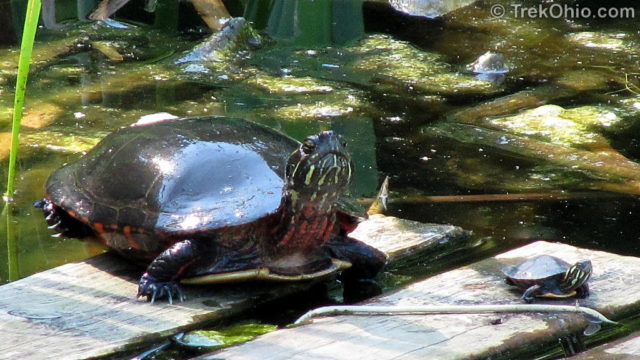
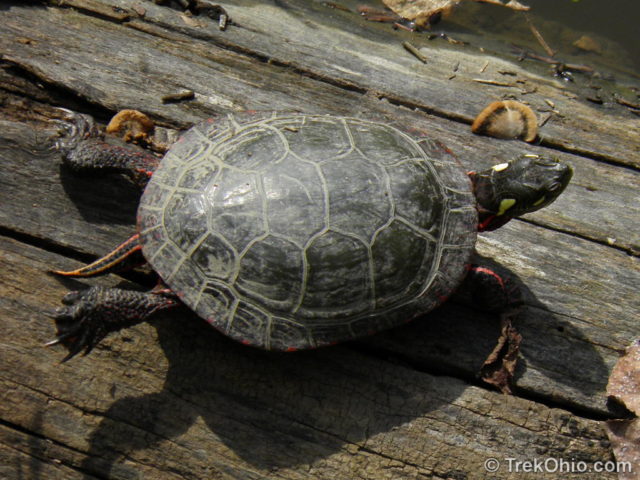

This is one of the most common turtles in Ohio, plus it’s easy to spot because it enjoys basking on logs or other objects near the water’s surface. To make it even more noticeable, it often basks in groups.
The carapace (upper shell) of the Midland Painted Turtle reaches between 4.5 and 5.5 inches in length, and it’s very dark green (nearly black). The turtle gets it’s “painted” characteristic from the bright red markings along the outer edge of its shell. The head typically has yellow stripes which may become red near the shell. The legs may also have red stripes.
Since 1976 Midland Painted Turtles have been sighted in the following Ohio counties: Adams, Ashtabula, Athens, Belmont, Brown, Butler, Champaign, Clark, Darke, Delaware, Geaugua, Guernsey, Hamilton, Knox, Lake, Licking, Lorain, Lucas, Marion, Medina, Miami, Morrow, Ottawa, Pickaway, Pike, Portage, Preble, Summit, Trumbull, Vinton, Wayne, Williams. Prior to 1976 the turtle was sighted in additional counties.
For more information, check out this Wikipedia page on Painted Turtles. Although this Wikipedia articles discusses several varieties of painted turtle, only the Midland Painted Turtle lives in Ohio.
Red-eared Slider (Trachemys scripta elegans)
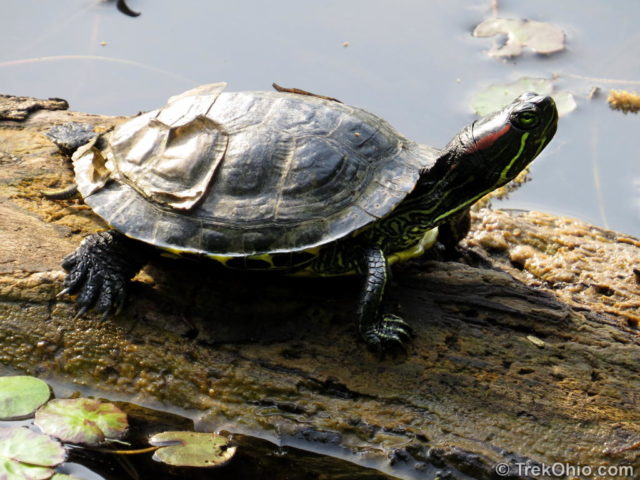
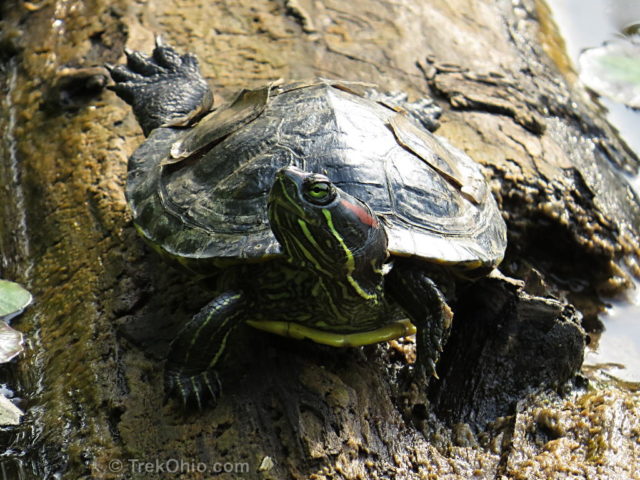
The carapace (upper shell) of the Red-eared Slider reaches 5 to 8 inches in length. Although the yellowish lines found on our Midland Painted Turtle may turn reddish near the shell and be mistaken for a “red ear”, here are a couple of things to keep in mind to distinguish the two. The carapace of a Midland Painted Turtle is an almost uniform, dark color with red spots around the edge (when seen from above). But the carapace of the Red-eared slider is lighter, and more variable in color with lighter brownish green areas and no red spots around its edge. If you look at the limbs of a Midland Painted Turtle, you’ll note that there is typically some red on the turtles legs. This is not true of the Red-eared Slider. And finally if you note the counties where the two species have been seen, you’ll see that the distribution of the Midland Painted Turtle is much more wide in Ohio.
The Red-eared Slider is a native to the Southern United States. It is believed that the ones found in Ohio are the offspring of pets that were released into the wild. Doing this is a really bad idea. In California where the Red-eared Slider was released, it is in the process of out-competing the native western pond turtle.
Since 1976 Red-eared Slider Turtles have been sighted in the following Ohio counties: Butler, Greene, Hamilton, Licking, Mahoning, Pickaway, Summit.
For more information, check out the Wikipedia page on Red-eared Slider Turtle.
Spotted Turtle (Clemmys guttata)
The carapace (upper shell) of these turtles is usually between 3 and 4.7 inches. The background color of the shell varies from black to a bluish-black. The shell is sprinkled with yellow dots. It prefers to live in shallow wetlands and small streams, but may also be found in wet prairies and woods.
Since 1976 Spotted Turtles have been sighted in the following Ohio counties: Ashtabula, Clark, Cuyahoga, Greene, Hardin, Lucas, Ross, Trumbull, Warren. Their historic range included additional counties.
For more information, check out its Wikipedia page.
Wood Turtle (Clemmys insculpta)
If you see a wild turtle in Ohio, it’s probably not this species. Apparently a few specimens have been seen in northeastern Ohio, but we’re on the fringe of its range.
The carapace (upper shell) ranges from 6.3 to 9.8 inches long and is brown to grayish-brown in color. The head is black (it may or may not have spots on it). The throat may have a yellow, orange or red tint. They may be found in diverse habitats, but they prefer moving water with sand or gravel bottoms.
For more information, check out its entry in the University of Michigan’s Critter Catalog.
Eastern Box Turtle (Terrapene carolina carolina)
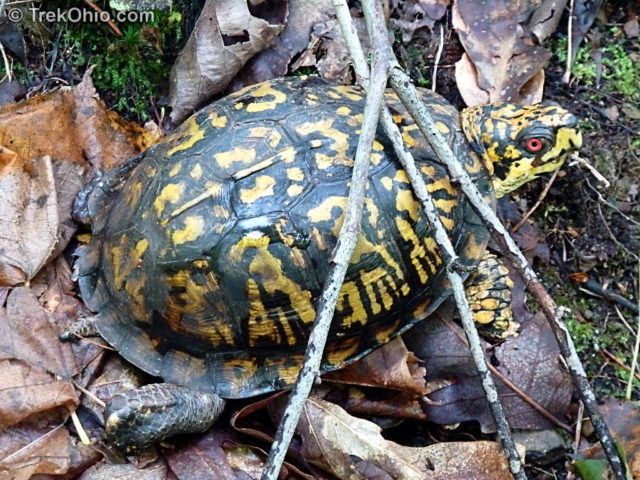
The carapace (upper shell) has a very high dome and reaches between 4.5 and 6 inches in length. The color of the upper shell varies; the background color it typically brown to black with yellow markings. The plastron (lower shell) has hinges in the front and back which allows the turtle to completely withdraw into its shell and shut the doors behind it. The ability to close itself within its “box” is how it got its name.
This is Ohio’s most terrestrial turtle which puts it at risk of being hit by cars as it tries to make its way slowing across a road. If it manages to avoid this fate, it is a very slow-maturing, but long-lived turtle. In the wild it can reach 100 years of age.
During the summer it keeps cool during the day by hiding in the shade or burrowing into leaf litter. It’s most active early in the morning and in the evening. If we’ve been having a dry spell, a rainy day will bring it out.
Since 1976 Spotted Turtles have been sighted in the following Ohio counties: Adams, Athens, Belmont, Butler, Clermont, Clinton, Cuyahoga, Erie, Franklin, Gallia, Greene, Guernsey, Jackson, Hamilton, Hocking, Knox, Meigs, Monroe, Montgomery, Morgan, Pickaway, Pike, Preble, Ross, Scioto, Vinton, Warren, Washington. Their historic range included additional counties.
For more information, check out its Wikipedia page.
Blanding’s Turtle (Emydoidea blandingii)
According to Wikipedia, the carapace (upper shell) ranges from 7.1 to 9.1 inches, but the Ohio Division of Wildlife says it ranges from 5 to 7 inches. Like the Eastern Box Turtle described above, the plastron (lower shell) has hinges in front and back, but the front hinge doesn’t work as well, so the Blanding’s Turtle can’t close up the front of its shell completely. The carapace has a dark background color with yellow specks. One of its most notable features is its yellow chin and throat.
In Ohio, Blanding’s Turtle is found in wetlands near Lake Erie. Occasionally it is seen walking overland from one wetland to another. Since 1976 it has been found in these Ohio counties: Cuyahoga, Erie, Lucas, Ottawa. In historic times it has been found in additional counties in Ohio’s northernmost regions.
Ohio Division of Wildlife video: Tracking the Secretive Blanding’s Turtle
For more information, check out its Wikipedia page.
Common Map Turtle (Graptemys geographica)
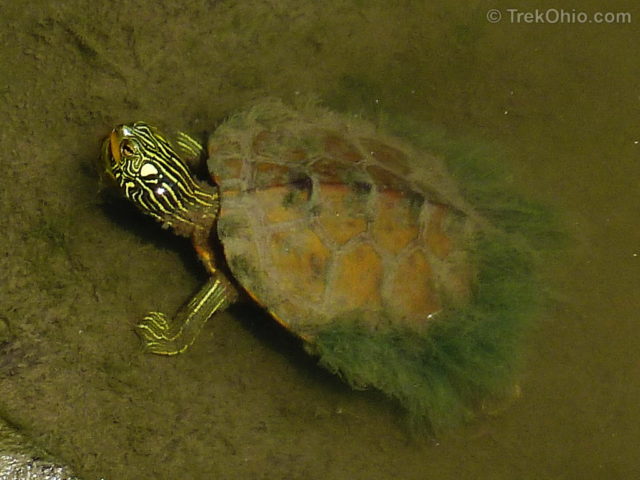
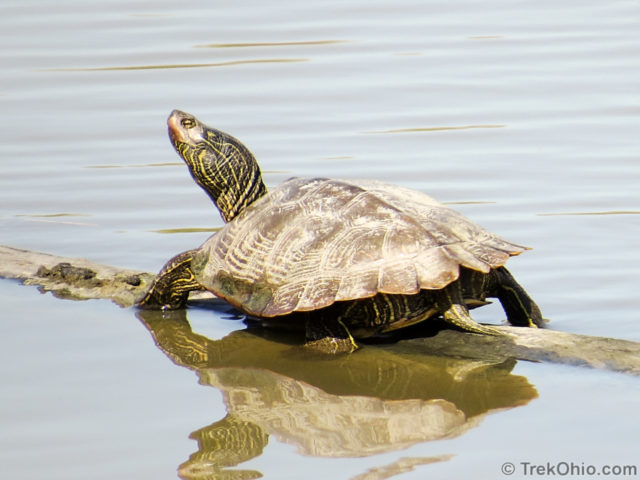
The female attains a length that’s about twice as big as the male. The carapace (upper shell) of the female gets to be about 10 inches long, while the male only makes it to about 5 inches. One very notable feature of the carapace is that there is a ridge running along the back from neck to tail. They are called “map” turtles because there are yellow lines on its back that are similar to those found on topographical maps. These lines are pronounced when the turtle is young, but they tend to fade away as the turtle grows older. The heads and limbs have yellow stripes.
These turtles like deep water, so they are typically found in lakes and large rivers. They are very wary about people and will quickly slip away into deeper water if a person draws close. They are the least likely turtle to be hibernating in the winter and have been spotted walking around under the ice.
Since 1976 Spotted Turtles have been sighted in the following Ohio counties: Adams, Columbiana, Marion, Ottawa, Pickaway, Williams. Their historic range included additional counties, such as Delaware where I photographed the turtle with algae on its back seen above.
For more information, check out its Wikipedia page.
Ouachita Map Turtle (Graptemys ouachitensis)
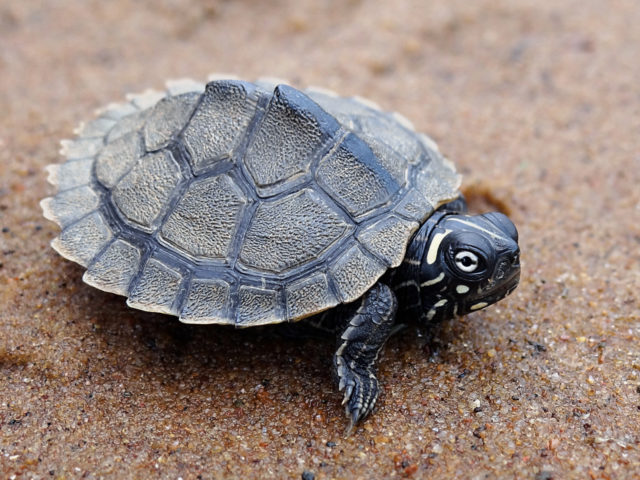
Ouachita Map Turtle (Graptemys ouachitensis); note the spines on the ridge of the back. Also note the yellow dot under each eye and on each side of the jaw.
Like the Common Map Turtle, the female Ouachita Map Turtle grows much larger than the male. The carapace (upper shell) of the female can reach a length of 10.75 inches while the male’s carapace reaches a length of 5.75 inches. Also like the Common Map Turtle there is a yellow blob behind each eye. Unlike the Common Map Turtle, the Ouachita Map Turtle also has a yellow blob under each eye and on each side of its jaw. The two species of map turtle are also similar in that both species have a ridge on their carapaces that runs from neck to tail. However this ridge is somewhat different in the Ouachita Map turtle because its ridge has spines.
Since 1976 Ouachita Map Turtles have been sighted in the following Ohio counties: Pickaway and Ross.
For more information, check out its Wikipedia page.
Family Chelydridae
Snapping Turtle (Chelydra serpentina)
This is Ohio’s largest turtle. The carapace (upper shell) typically ranges in size between 10 and 19 inches, and these turtles usually weigh between 10 and 35 pounds. They are very aggressive if approached when they are outside of the water, and they have very powerful jaws. Unlike many turtles, about the only time they bask is at the very beginning of spring.
The turtle below has pulled his head in as much as possible.
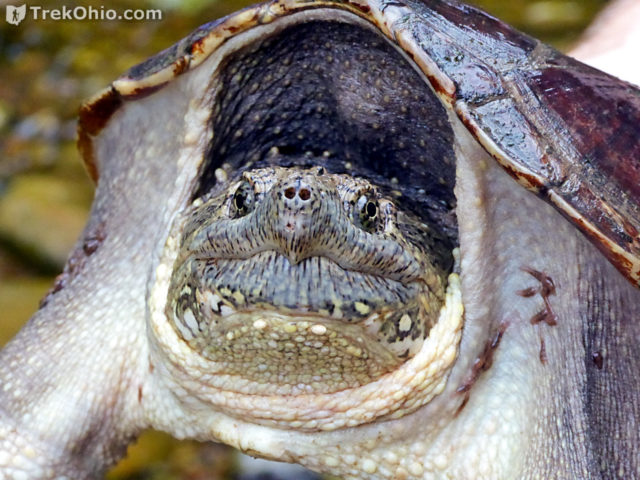
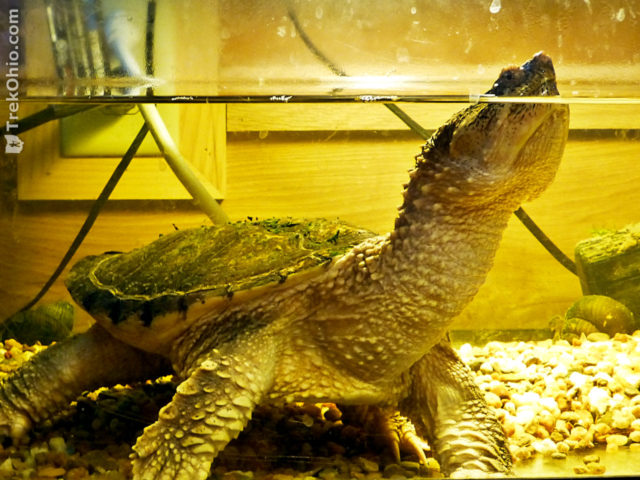
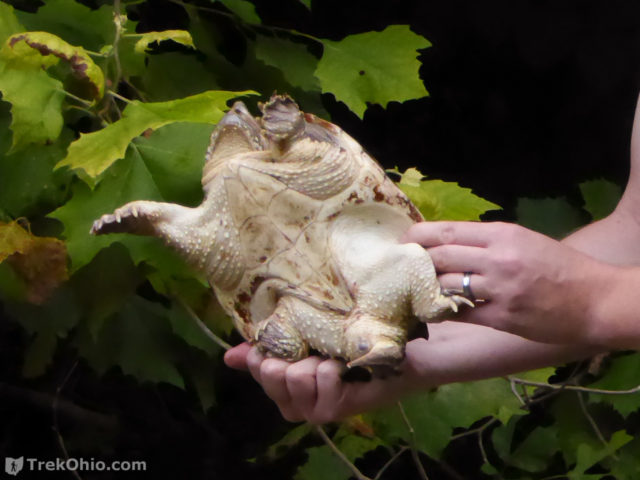
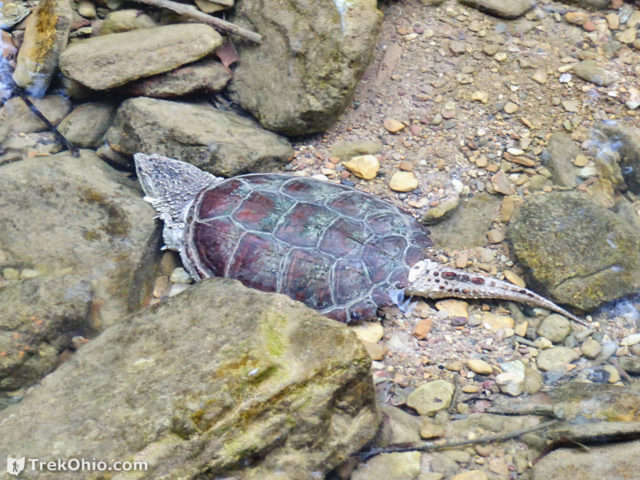
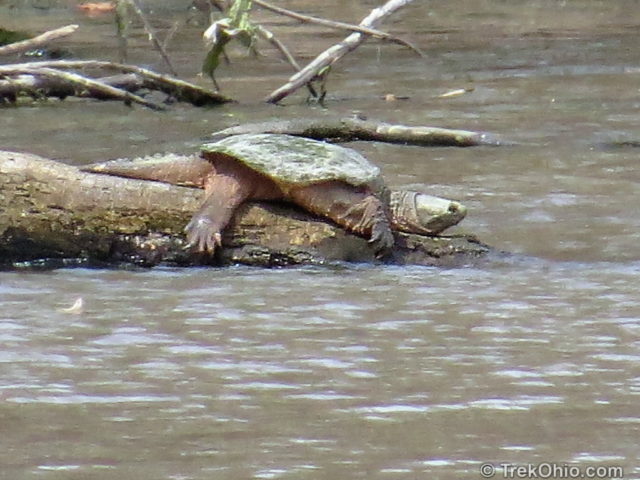
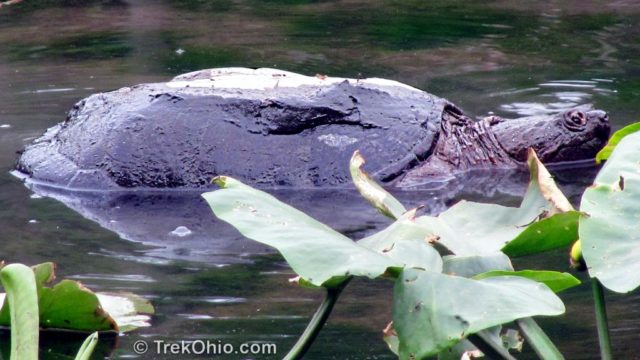
Since 1976 Snapping Turtles have been sighted in the following Ohio counties: Adams, Ashtabula, Athens, Belmont, Butler, Clermont, Clinton, Delaware, Erie, Fairfield, Franklin, Hamilton, Knox, Lake, Logan, Madison, Marion, Medina, Ottawa, Pickaway, Pike, Portage, Preble, Vinton, Warren, Wayne, Williams, Wood. Its historic range includes additional counties.
For more information, check out its Wikipedia page.
Family Kinosternidae
Common Musk Turtle (Sternotherus odoratus)
The carapace (upper shell) of this turtle ranges in length between 2 and 5.5 inches; it has an average weight of 1.33 pounds. It’s most distinctive mark is the yellow stripe near each eye. The “odoratus” in the scientific name is there because these turtles secrete a stinky, yellowish musk when alarmed. They will bite if they feel a need to protect themselves.
Since 1976 Common Musk Turtles have been spotted in the following Ohio counties: Clark, Hamilton, Jackson, Licking, Perry, Pickaway, Pike, Portage, and Scioto. Note that their historic range includes additional counties, so you may see one outside of the counties that I just listed.
These turtles are rarely seen outside of the water unless they are laying eggs. Surprisingly the female may not bother burying her eggs. All that matters to her is that the egg-laying site to be near the water.
For more information, check out its Wikipedia page.
Family Trionychidae
Eastern Spiny Softshell Turtle (Apalone spinifera spinifera)
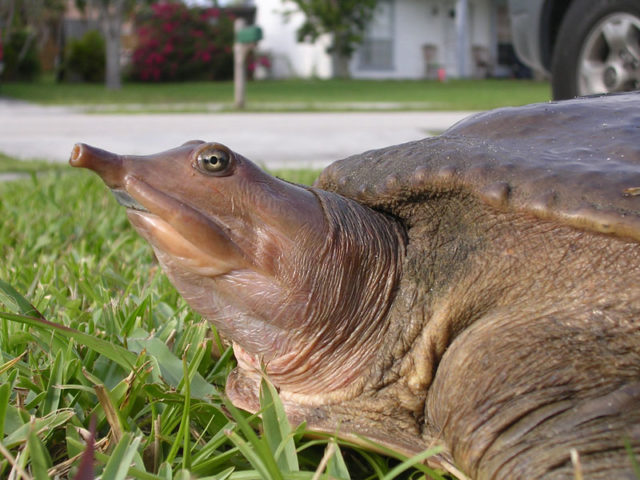
Eastern Spiny Softshell Turtle (Apalone spinifera spinifera) — The little bumps along the front, top shell are the “spines”.
This is another turtle species where the females grow to be much larger than the males. The carapace (upper shell) of the female can attain a length of 7 to 17 inches making it one of the largest freshwater turtles in North America. In contrast the male’s carapace only grows to between 5 and 9 inches. On the leading edge of this turtle’s carapace, there are a series of conical projections under its rubbery shell which is why this turtle is said to be “spiny”. Unlike the Midland Smooth Softshell Turtles, the Eastern Spiny Softshell Turtle has circular spots all over their backs, often with a noticeable ring around the spot.
There’s something about the rubbery shell and the long rubbery-looking snout that makes the turtle seem kind of peaceable. However this turtle is just as aggressive as a snapping turtle.
It is an excellent swimmer; its preferred habitat is the shallow portions of rivers where it will bury its body in sand or mud with just its head sticking out. Surprisingly it can “breathe” underwater. It can pump water in and out of its highly vascular pharynx and extract oxygen directly from the water.
Since 1976 Eastern Spiny Softshell Turtles have been sighted in the following Ohio counties: Ashtabula, Butler, Clark, Clermont, Clinton, Coshocton, Fairfield, Gallia, Hamilton, Licking, Logan, Lorain, Muskingum, Pickaway, Preble, Montgomery. Prior to 1976 it was seen in additional counties not listed here.
For more information, check out the Wikipedia page on Spiny Softshell Turtles. Although this page discusses several varieties of spiny softshell turtles, only the Eastern Spiny Softshell Turtle lives in Ohio.
Midland Smooth Softshell Turtle (Apalone mutica mutica)
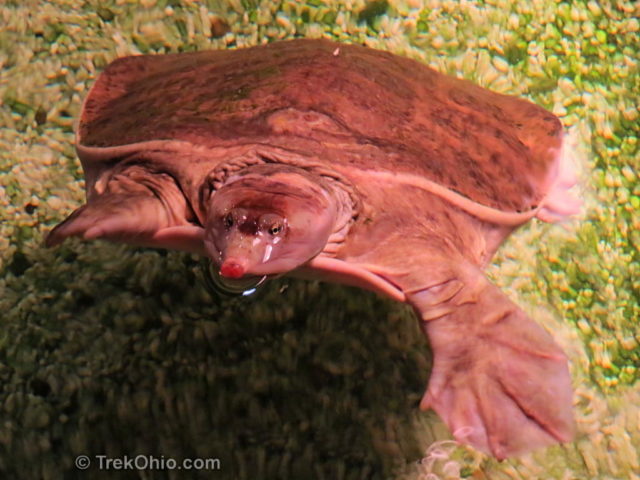
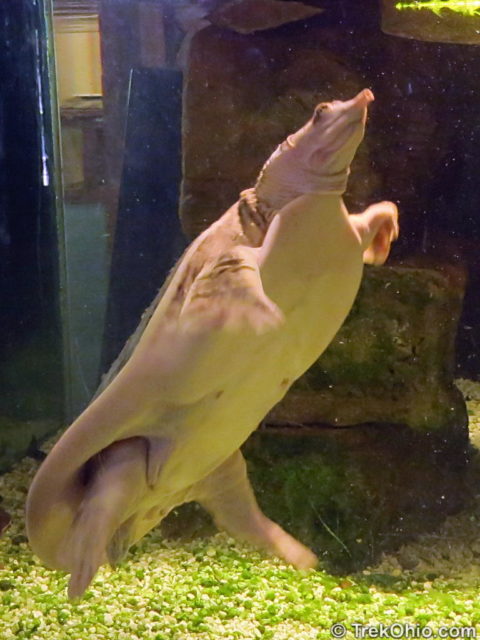
In this species the female is also larger than the male. Her carapace (upper shell) reaches a length of 6 to 14 inches, while the male’s carapace only reaches 4 to 7 inches. Unlike the Eastern Spiny Softshell Turtles described above, the Midland Smooth Softshell Turtles does not have regular, circular spots on its back. What markings it does have on its shell are small, blotchy-looking little things. It likes to live near or on sandbars in large rivers.
Since 1976 Midland Smooth Softshell Turtles have been sighted in the following Ohio counties: Clermont, Hamilton, Muskingum. Prior to 1976 it was sighted in a few other counties not listed here.
Keeping Wild Turtles as Pets
I’ve been getting a number of comments asking about what you have to do to legally keep a wild turtle as a pet here in Ohio. The Ohio Department of Natural Resources (ODNR) describes this process at their website. Once you land on this page, it might not be obvious where to look, but it turns out that you want to click on the tab called Wild Animal Propagation. Here is the relevant information found there as of June 2, 2017.
To keep a wild turtle as a pet, you need to submit an application for a Noncommercial Propagating License which costs $25. According to the ODNR, you may keep up to four individual pets from their list of approved reptiles and amphibians. The website goes on to list four species of wild turtles that are okay to keep as pets. Your pet turtle must belong to one of the following species:
- Eastern Musk Turtle (Sternotherus odoratus)
- Midland Painted Turtle (Chrysemys picta marginata)
- Northern Map Turtle (Graptemys geographica)
- Red-eared Slider (Trachemys scripta elegans)
In general the biggest health concern that people should keep in mind while handling reptiles is being exposed to salmonella (a type of bacteria). It is important to wash your hands thoroughly with soap and water after handling a reptile. There’s an article about salmonella contamination in the Washington Post: Will that pet turtle make you sick?
Here are some web resources that discuss what is involved in caring for a midland painted turtle:
- Austin’s Turtle Page: Care Sheet – Midland Painted
- ReptilesMagazine.com: Painted Turtle Care Sheet
- TheTurtleSource.com: Care Sheet for Painted Turtles
- ExoticPets.About.com: Painted Turtles — includes a discussion of health problems that turtles might have, especially if not cared for properly.
I will note in passing that another visitor, Shelby, left a comment about keeping a midland painted turtle (see her comment here). It sounds like she kept one over the winter, and it was more difficult than she had anticipated.
Additional information
I obtained the county sighting information from a PDF document published in 2008 by the Ohio Division of Wildlife, Reptiles of Ohio Field Guide. The Ohio Department of Natural Resources (ODNR) also publishes a nice overview of our turtle species here. For an interesting, yet easy-to-understand presentation on the anatomy of a turtle’s shell, check out this Wikipedia article.
Jeffrey Davis is a naturalist associated with the Cincinnati Museum of Natural History. He is currently trying to update the location of Ohio’s various species of reptiles and amphibians. To help him get a more accurate understanding of the distribution of these species, Davis needs to see a photo of the animal so he can verify its species. If you are interested in helping him update the official record as to where these animals live in Ohio, you can email a photo of the specimen along with the location of your sighting (be as specific as possible with the location). His address is ohiofrogs@gmail.com. Despite the email address, you can use it to report a sighting of any amphibian or reptile.
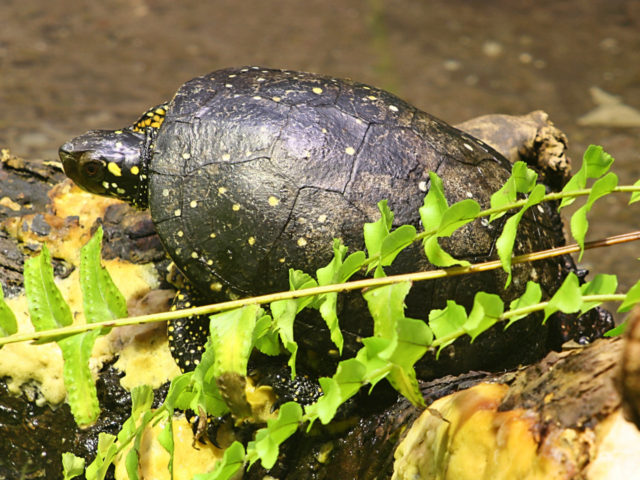
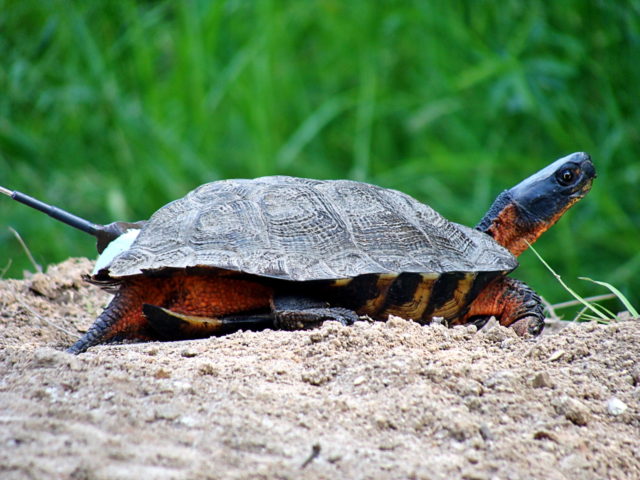
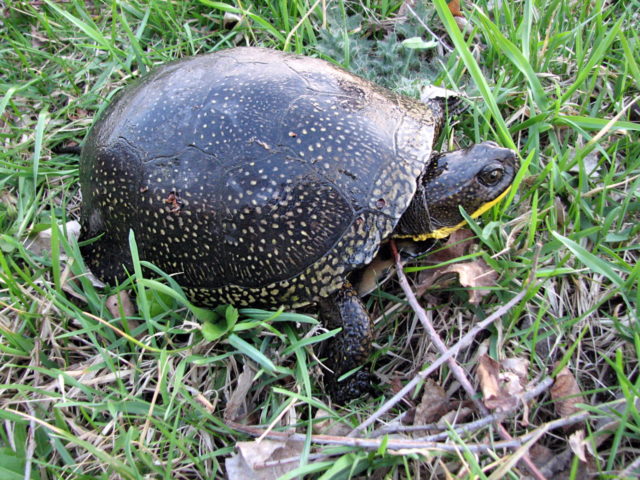
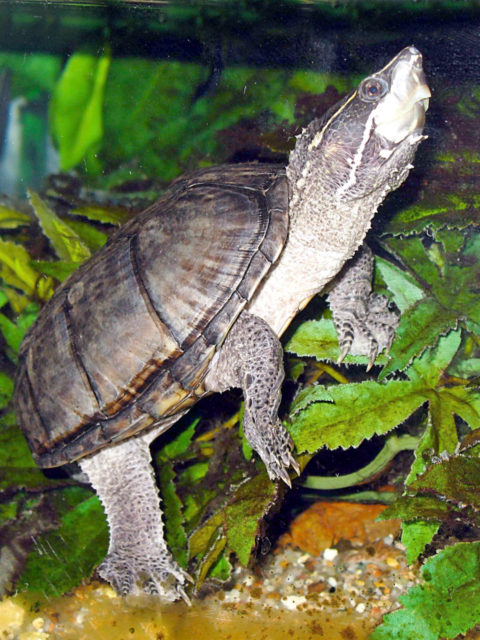
I love the website, but was unhappy to see that my county, Mercer, apparently has no turtles. I lived most of my life in central Ohio, and can remember a time when we actually walked our large yard before mowing to check for box turtles. When I found your website, I was sad to realize that I haven’t even seen a turtle, ANY turtle, in years. I’ve only lived here for about 10 years, but we have a lake (although it is periodically unsafe due to blue algae), creeks and rivers, as well as old portions of Ohio’s original canal system. Lots of water – how is it possible that there are no turtles here?
Just found a box turtle on my property in Highland county. My county wasn’t one of the ones listed.
The article has several places where the information is mixed up. The box turtle info went from box turtles to another one already mentioned. The same happened to others , too. Article needs to be proofread and fixed.
I was driving Saturday morning in Mt Healthy (a Suburb of Cincinnati ) Pippin Rd. I spotted a large turtle ready to make a suicide run across a busy road So I Stopped my car ,ran over to her (she was quite large olive green shell maybe 13″” long )Thats why I thought it was a snapper
One of the biggest Turtles I’ve seen in my 71 years I was surprised how fast and aggressive she was when I picked her up and deposited her toward the creek that ran parallel to the road .Glad I saved her hope she stays in the creek What a interesting Ohio reptile First soft shell I’ve ever seen, Steve Gardner
Nice page here, with excellent and concise info.
I have spotted a Northern Map turtle on my farm in Delaware county, near Union and Marion counties. When did you take the picture of the map turtle in Delaware county?
There are snapping turtles in Licking County. Three years ago, I posted a video of one that I rescued after a flood, from Beecher Road, near Outville Road, in Harrison Township, Pataskala, Ohio.
I just found an eastern box turtle crossing a real busy road out in lyons ohio. The part of the road that it was crossing has houses all along it. I have it in a cage right now till I can figure out if a park would take it or if I can let it go in some woods farther down the road. I do not wantto let it go next to house and get hurt or killed. Can I let it go farther down the road or will it die. My wife said to just let it go next to the houses but I would rather let it go where it would have a good chance to live than someone or something hurting it near a house.
We find snappers in our pond all the time, that’s bad bad bad. We generally shoot them and if large enough we have eaten them.
We just found an eastern box turtle in the oak openings region in western Lucas County. A coyote or something went at him at one point at the front of his shell but he was healed. Just wanted to add to the counties where they might be found.
I found what I think to be a red eared slider. We found it in Powell, Ohio zipcode 43065 in Powell Place the neighborhood.
So my husband found a eastern box turtle crossing a road in lucasville ohio. He brought it home for our kids to see. And now is afraid of setting it loose because he heard that box turtles will wonder around in wild trying to get back to where he picked it up at. Unfortunately we live about 45 mins away from where he found it, so he’s afraid it will wonder til it dies. Is this true about box turtles? We have kept it outside in grass filled cage with pan of water it lives to sit in & we have been feeding it worms. It seems to eat them well.
You can add Ashtabula County to the list of counties where an Eastern Box Turtle has been spotted. We found one today! He appears to be an older male.
Thanks for a very helpful website! I’m sure my family members saw a gigantic snapping turtle in Solon (Cuyahoga County) in May 2014. I have a head-on cellphone photo of it on the grass, and my son had a better one (sideways) at the door of their neighbor’s house! If it would be useful, I’ll send you the one I have and ask him if he still has the other one.
we have what looks to be an adult musk turtle that has taken up residence in our decorative backyard pond. it hangs out under the water hyacinth and lily. but each day when i feed our fish (who have learned to beg) the turtle comes out and begs as well – too cute! it doesn’t bother the fish, and they don’t seem to mind the turtle. it has quite a long growth of algae on its shell, so we’ve named it “shag” (as in shag rug)
wondering if we should move it to a nearby larger pond, or just assume it can take care of itself…..
we’re in brimfield – southeast of kent, oh.
I think it is a safe bet that the turtle has already chosen an appealing habitat (your backyard pond), and that it will move on its own if the pond no longer seems to be meeting its needs. I enjoyed hearing about the turtle’s skirt of algae, and of his begging for food. 🙂
We used to belong to the resort here in Wapakoneta Ohio and my children found smooth softshell & musk turtles all the time in their lakes.
Today we found what we think is a Midland Smooth Soft Shell Turtle in the Great Miami River in Fairfield, Ohio. That is Butler County. It is flat, smooth, and soft. Very strange looking creature.
Seems to be a baby. Only about an inch n a half in diameter. We had just rescued a baby snapper and released it, then we found this one. What do they eat? Are they rare?
You may want to look at my reply to someone else’s comment on keeping a wild turtle as a pet which you can view here. It describes the licensing process and includes a few links on caring for a turtle.
However when you look at the list of wild turtles that are okay to keep at home as pets, it is a very short list of species (you can view the list which is at the Ohio Dept. of Natural Resources). Here is the relevant bit:
As you can see Midland Smooth Soft Shell Turtles are not on the list. This would seem to suggest that you aren’t allowed to keep this particular species as a pet, and you should probably release it back into the wild.
Today my son found a tiny 50 cent piece size turtle. we had never seen one like it before. I had to look up what kind he was. He was an eastern softshell! We were on the Wv side of the Ohio river in New Martinsville, wetzel county. We took a picture of him and released him back into the water. It was neat to find a new one we had never seen. Thanks for all the info!!
Amy, what a great find! I’ve never seen a tiny one like that.
Found a midland painted turtle today infairfield county. The little guy was moving at a pretty good clip across our driveway. I supposed he was heading toward the 2 acre pond on the property. I saved him a good 300 yard walk and released him about 6ft from the ponds edge. He fooled around a little while then took the plunge. The last I saw hime he looked happy as a turtle can get.
Hi there! About 2 days ago my daughter & I were driving past a wetlands area behind a strip mall in northern franklin county & we saw a huge turtle or what I actually thought was a tortoise. It was I’d say over a foot long (shell) at least, that was a grey/brown color with huge legs & head also greyish in color. It was up away from the water digging in some mulch by a tree & it had big claws it was digging with. I have a Zoology degree & am somewhat familiar with wetland species & this very much looked like a tortoise to me. Are tortoises native to ohio? Unfortunately, I had to drop my daughter off at gymnastics practice & when I went back to take a closer look, I couldn’t find it 🙁 I was worried maybe someone let a pet tortoise (that got a bigger than expected) go in this area.